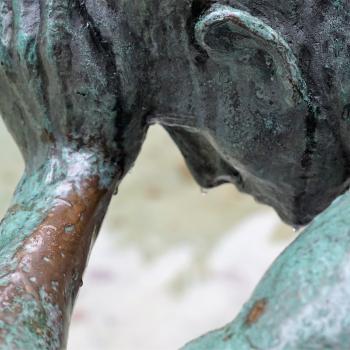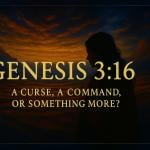The show’s dramatic theme song prepped the audience for a thrill; the deep voice announced the following: “The story you are about to see is true; the names have been changed to protect the innocent.” Sgt. Joe Friday, confronted with auto theft, kidnapping, and murder, pursues the villain through clues and terse interviews – “just the facts, Ma’am.” (And why is it always “ma’am” as though it’s always the women who muddle up the account with emotion and embellish it with opinion? Harrumph. Just like the apostles, who were sure the first witnesses to the Resurrection – women – were all speaking nonsense.)
The show was all about the evidence. Every crime could be solved through hardboiled, empirical reason. The clues. The timing. The motives. The witnesses. Friday would announce the date, the time, and the location of every scene. It all came together. No one got away with anything. Joe Friday – mild-mannered but driven, courteous but determined, unprepossessing but clever – made it look easy. Frank Smith, Joe’s sidekick, provided some chatty, homey relief to the action, but it was Joe, and only Joe, who solved the mystery. Joe was smart, insightful, and wise – he was a hero every week.
Unfortunately, we often approach faith the same way. We know something happened. But what? When? Where? Who saw it? Rationalist, Enlightenment-drive thinking tells us that if we put together all the evidence, we should be able to reach a hard conclusion about the factuality of the matter. It’s a little trickier now that the Event is 2,000 years old. But still, “just the facts” is all we need.
Many years ago I heard a speaker relate a situation that has, for me, provoked considerable reflection over the years about the nature of faith. He told of posing this question to an audience: “If you could exchange the four Gospels — with their testimonies of Jesus’ teaching and actions, passion and crucifixion, resurrection and ascension — for an actual video of Jesus’ life, would you do so? A video that showed the angel Gabriel hovering in a golden mist over Mary; that showed Jesus multiplying the loaves and fish; that showed water being poured into the pitchers and wine coming out; that showed Lazarus staggering out of a darkened hole in the ground; that showed Jesus taking a little dead girl by the hand and lifting her up; that showed Jesus breaking bread, sweating blood, lurching under the cross, nailed, gasping, dying; that showed the early sunlight streaming into an empty tomb; that showed a very alive Jesus munching on a piece of fish; that showed Jesus seeming to vanish into the Galilean sky… Would you like that?”
Of course we’d like that. To really see it all for ourselves. That would solve our dilemmas, answer our questions, quiet our doubts.
But of course it didn’t for those who were there. Many saw, and did not believe. They tasted the water-turned-to-wine; they ate the bread that never ran out; they watched a dead man stumble into the light; they saw the blood dripping down the wood of the cross. It wasn’t enough. The evidence certainly demanded a verdict, but that verdict wasn’t unanimous.
So, while we can say that yes, there is evidence that supports faith, we cannot say that faith is an inevitable conclusion of the evidence.
There is a missing ingredient.
Some atheists might suggest it’s a meme, or a bit of DNA that triggers credibility. Perhaps. But maybe it’s revelation, a disclosure to the soul that kindles the spiritual “aha!” of conviction.
When I was a teenager, I had a youth pastor who, in one of our Bible studies, claimed that he had moved past the point of believing into certain knowledge. “I don’t believe that Jesus is the Son of God… I know that Jesus is the Son of God!” Weird. I thought that then, and I still think that now. If we pit faith against knowledge like that, then we have rejected the vulnerability that comes with the willingness to risk.
Faith is risky. Pascal called God the Deus absconditus, the hidden God, who gives enough light for those who wish to believe, and enough obscurity for those who do not wish to believe. That requires of those who choose faith a posture of humility rather than power.
Next posting “Could Be Wrong … but I Don’t Think So.”













